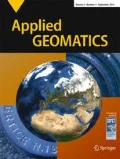Abstract
IT experts believe that cloud computing is turning into the fifth vital human needs preceded by water, electricity, gas, and telecommunications. In line with this trend, one of its major applications is in the swiftness enhancing of disaster management entities. This research, by using the huge capacities of cloud computing, aims to design a system to promote the performance of relief operations in disaster hit areas. The architecture of the designed system consists of two parts: hardware and software. In the hardware side, using NIST standards, the assessment function designed by Iran’s Passive Defense Organization, also applying Tehran’s telecom infrastructures plans and selecting 20 main centers in Tehran, a high bandwidth and widespread network of fiber optic infrastructure as the physical backbone of our cloud-based system has been exploited which covers all areas of the city. In the software part, an application has been developed using the ASP.net capabilities in the Microsoft Visual Studio to collect and integrate the data gathered by early dispatched relief groups. Based on the special prioritization algorithm designed by Iran’s passive defense organization, the application is capable of providing information by analyzing various spatial data. By processing and unifying the input data into the DBMS, the designed service offers a wide range of capabilities including real-time spatial tables, graph and curve generation, and different special-temporal queries in prioritizing the quake hit areas, recognizing and targeting the most severely hit ones. The mentioned capabilities enable city managers and decision makers to enhance the accuracy, swiftness, and effectiveness of relief operations.









Similar content being viewed by others
References
Aly A, Labib M (2013) GIS based cloud computing architecture for emergency systems. Int J Eng Adv Technol (IJEAT) 3:373–379
Ashtari M, Hatzfeld D, Kamalian N (2005) Microseismicity in the city of Tehran. Tectonophysics 393:193–208
Buyya R, Yeo C, Venugopal S, Broberg J, Brandic I (2009) Cloud computing and emerging IT platforms: Reality for delivering computing as the fifth utility. Futur Gener Comput Syst 25:599–616
Donnellan A, Glasscoe M, Parker JW, Granat R, Grant L (2013). Integrating remotely sensed and ground observations for modeling, analysis, and decision support. IEEE Aerospace Conference Proceedings. IEEE, Big Sky
Evangelidis K, Ntorous K, Makridis S, Papatheodorou K (2014) Geospatial services in the Cloud. J Comput Geosci 63:116–122
Farajisabokbar HA, Fereidouni F, Salmani M, Karimzade H, Rahimi H (2007) Landfill in the Rural Areas Localization Using Networking Process (ANP) in Rural Areas Is a City Ghouchan Analysis. Q J Hum 127:149
Goodchild M, Huang Q, Nebert D, Raskin R, Xu Y, Bambacus M, Fay D (2011) How geospatial sciences could use and help to shape cloud computing. Int J Digit Earth 17:28–49
Hashemi M, Alesheikh A, Zolfaghari M (2013) A spatiotemporal model for probabilistic seismic hazard zonation of Tehran. J Comput Geosci 58:8–18
Mahdikhani M, Bayati Z (2008) “Application and development of fiber optic sensors in civil engineering”. Conference on Earthquake Engineering October 12–17, 2008, Beijing, China
Mahmudzadeh M (2014). Crisis management in telecommunications. Retrieved August 11, 2014, from http://tct.ir/?fkeyid=&siteid=1&pageid=995
Mazdak A (2014) Earthquake preventive measures in Tehran. Retrieved May 1, 2014, from http://en.tehran.ir/default.aspx?tabid=17&Articleld=3002
Sadughi R (2014) Telecommunication infrastructure in Iran. Retrieved December 4, 2014, from http://www.tic.ir/Default.aspx?Lang=en#
Saydi M, Valadan Zoej MJ, Mansourian A (2011) Design and implementation of a web-based GIS (in response phase) for earthquake disaster management in Tehran city, ISPRS High Resolution Earth Imaging for Geospatial Information Workshop, 14–17 June, Hannover, Germany
Sui D (2014) Opportunities and impediments for open GIS. Transactions in GIS 18(1):1–24
Wang J, Pierce M, Ma Y, Fox G, Donnellan A, Parker J, Glasscoe M (2012) Using service-based geographical information system to support earthquake research and disaster response. Comput Sci Eng 5:21–30
Westen CJ (2013) Remote sensing and GIS for natural hazards assessment. Int J Remote Sens GIS Sci 3:259–298
Zare, M. (2013) GIS and earthquake engineering. Retrieved January 2, 2014 from http://www.iiees.ac.ir/fa
Author information
Authors and Affiliations
Corresponding author
Rights and permissions
About this article
Cite this article
Sadidi, J., Fakourirad, E. & Zeaieanfirouzabadi, P. Designing a spatial cloud computing system for disaster (earthquake) management, a case study for Tehran. Appl Geomat 10, 99–111 (2018). https://doi.org/10.1007/s12518-018-0203-9
Received:
Accepted:
Published:
Issue Date:
DOI: https://doi.org/10.1007/s12518-018-0203-9




